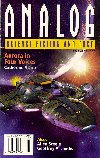I don't tend to buy SF magazines any more --
too many books, too little time, so
I have to prioritise, and I tend to prefer novels to short stories
nowadays. And when I do choose to read short stories, in books, they come
lumped together as author collections or themed anthologies. But, I was
given a copy of this issue [disclaimer: by one of the included authors],
read it, and was reintroduced to the experience of reading a bunch of
stories and articles related neither by author nor by theme (apart from
all being SF, of course). It made a pleasant change.
Contents
- • Quality Control II: Reminder and Speculation. 1998
- On the importance of complaining, if we want quality to improve
- • Catherine Asaro. Aurora in Four Voices. 1998
- (How Soz and Jato met, 16 years before the events told in Primary
Inversion.) Jato is trapped in Nightingale, a city in
permanent darkness, inhabited by mathematical artists who mostly ignore
him. Soz arrives to repair her ship, meets Jato, and finds herself
involved in his problems.
- More of Asaro's great way of writing interesting characters living in
a well-thought-out future-tech world. In particular I liked the
interaction with the computer: a credible verbal interface, and not a
'subroutine' in sight.
- • Tom Ligon. The World's Simplest Fusion Reactor. 1998
- How to build a clean, non-thermal fusion reactor, as a school science
fair project.
- This article gave me a real jolt of that wonderful excitement I got
from reading engineering SF as a teenager. They do write them
like that any more!
- • Geoffrey A. Landis. Outsider's Chance. 1998
- He never really believed in space pirates, but now a crew is trying
to hijack his cargo of frozen oxygen. So he invites one of them over for
coffee to discuss things. Politeness is important on the frontier, after
all.
- • Fran Van Cleave. Ataxia in Ataraxia. 1998
- • Jeffery D. Kooistra. The Alternate View. Calling Dr. Diogenes. 1998
- (non-fiction) A call for help from someone who has diagnosed his own disease, but
can't get doctors to listen to him
- • Bud Sparhawk. High Flight. 1998
- A meteorologist on Jupiter has to re-evaluate the reasons why she is
there
- • Allen M. Steele. Zwarte Piet's Tale. 1998
- Colonial life on Mars is harsh, but maybe it doesn't take that much
to put some magic back into things.
- [I liked this more than the few Steele novels I've read so far,
because the protagonists aren't such slobs, or, at least, their
slobbishness isn't dwelt upon so much.]

